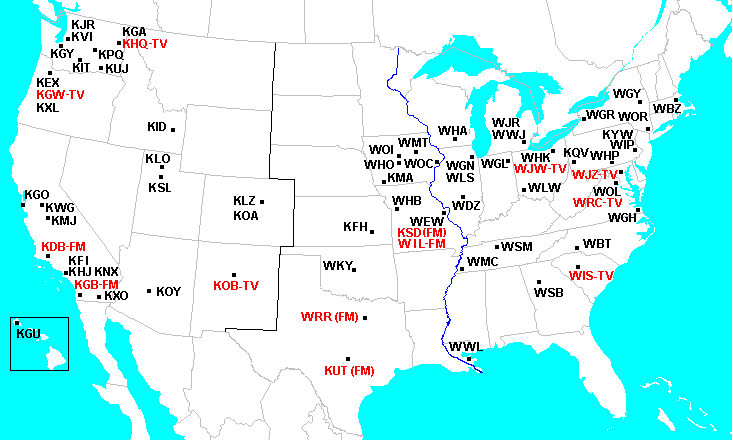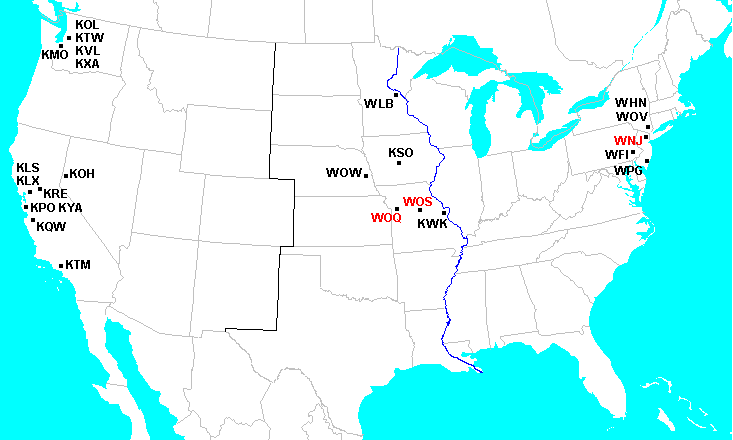Total
on AM
=====
01/01/1932 status as of this date 93
01/26/1932 KUT AUSTIN, TX became KNOW (now KFON -- see 8/21/1958) 92
05/09/1932 WOC DAVENPORT, IA consolidated with WHO Des Moines 92
as WHO-WOC (see 11/11/1934)
06/02/1933 WNJ NEWARK, NJ. Station deleted. 91
06/14/1934 WOQ KANSAS CITY, MO. Station deleted. 90
11/11/1934 WOC DAVENPORT, IA. Call split-off from WHO-WOC 90
Des Moines, moved to x-KICK Davenport (see 5/9/1932)
12/03/1934 KYW CHICAGO, IL station moved to Philadelphia, PA 90
(see 2/13/1956)
01/21/1935 WFI PHILADELPHIA, PA. Station consolidated with WLIT 89
as WFIL
03/17/1935 KSO DES MOINES, IA. Called transferred to x-KWCR, 89
old KSO became KRNT (see 9/11/1989)
05/06/1935 KTM LOS ANGELES, CA became KEHE (now KABC) 88
03/27/1936 WOS JEFFERSON CITY, MO. Station deleted. 87
12/15/1936 KVL SEATTLE, WA became KEEN (now KPTK) 86
01/03/1940 WPG ATLANTIC CITY, NJ consolidated with WBIL and WOV 85
as "new" WOV (see 11/12/1941)
01/28/1941 WOR NEWARK, NJ. Station moved to New York, NY 85
11/12/1941 WOV NEW YORK, NY swapped calls with WNEW 85
(now WBBR--see 11/1/1959)
05/06/1944 KJR SEATTLE, WA swapped calls with KOMO 85
06/01/1945 WLB MINNEAPOLIS, MN became KUOM 84
09/10/1945 KLS OAKLAND, CA became KWBR (now KMKY) 83
11/12/1947 KPO SAN FRANCISCO, CA became KNBC (now KNBR) 82
09/15/1948 WHN NEW YORK, NY became WMGM (see 2/28/1962) 81
04/03/1949 KQW SAN FRANCISCO, CA became KCBS 80
02/20/1950 WOL WASHINGTON, DC swapped calls with WWDC (now WWRC) 80
03/01/1953 WJZ NEW YORK, NY became WABC (see 8/5/1957) 79
02/13/1956 KYW PHILADELPHIA, PA. Call moved to x-WTAM Cleveland, OH 79
(x-KYW in Philadelphia became WRCV--see 6/19/1965)
Not
Total on All
on AM AM Bands
===== ==== =====
08/05/1957 WJZ BALTIMORE, MD. Call reactivated for TV 79 1 80
station (see 3/1/1953)
08/21/1958 KUT AUSTIN, TX. Call reactivated for FM station 79 2 81
see 1/26/1932)
06/07/1959 KLX OAKLAND, CA became KEWB (now KNEW) 78 2 80
11/01/1959 WOV NEW YORK, NY became WADO (see 11/12/1941) 77 2 79
06/29/1960 KYA SAN FRANCISCO, CA became KDBQ (see next) 76 2 78
07/13/1960 KYA SAN FRANCISCO, CA returns from KDBQ (prev.) 77 2 79
02/28/1962 WHN NEW YORK, NY returns from WMGM (see 78 2 80
9/15/1948 and 7/1/1987)
04/29/1963 KRE BERKELEY, CA became KPAT (see 6/11/1972) 77 2 79
06/19/1965 KYW CLEVELAND, OH. Call returned to Philadelphia 77 2 79
(x-KYW became WKYC, now WTAM--see 2/13/1956)
10/12/1969 KDB SANTA BARBARA, CA became KAPN (FM retains 76 3 79
three-letter call -- see next)
10/22/1969 KDB SANTA BARBARA, CA returns from KAPN 77 2 79
06/11/1972 KRE BERKELEY, CA returns from KPAT (see 78 2 80
4/29/1963, 8/13/1986)
08/30/1975 KTW SEATTLE, WA became KYAC (now KKDZ) 77 2 79
09/01/1975 KOL SEATTLE, WA became KMPS (now KKOL) 76 2 78
04/14/1978 WRR DALLAS, TX became KAAM (now KTCK -- 75 3 78
FM retains call)
03/15/1982 KGB SAN DIEGO, CA became KCNN (now KLSD -- 74 4 78
FM retains call)
04/18/1983 KMO TACOMA, WA became KAMT (now KKMO) 73 4 77
09/01/1983 WGH NEWPORT NEWS, VA became WNSY--see 12/10/1984 72 4 76
12/13/1983 KYA SAN FRANCISCO, CA became KOIT (FM retains -- 71 5 76
see 3/27/1994)
02/27/1984 WRC WASHINGTON, DC became WWRC (now WTEM -- TV 70 6 76
retains call)
03/19/1984 KSD SAINT LOUIS, MO became KUSA (FM retains 69 7 76
call -- see 10/4/1993)
06/01/1984 KWK SAINT LOUIS, MO became KGLD (now KSLG -- 68 8 76
FM retains call -- see 2/29/1988)
12/10/1984 WGH NEWPORT NEWS, VA returns from WNSY 69 8 77
(see 9/1/1983)
01/07/1985 KHQ SPOKANE, WA became KLSN (now KQNT -- TV 68 9 77
retains call)
06/11/1985 WJW CLEVELAND, OH became WRMR (now WKNR -- TV 67 10 77
retains call)
02/01/1986 KHJ LOS ANGELES, CA became KRTH (TV retains 66 11 77
call -- see 12/2/1989, 3/15/2000)
04/11/1986 KXA SEATTLE, WA became KRPM (now KTTH) 65 11 76
08/13/1986 KRE BERKELEY, CA became KBLX (now KVTO -- see 64 11 75
4/29/1963, 6/11/1972)
10/28/1986 KOB ALBUQUERQUE, NM became KKOB (TV retains call)63 12 75
12/31/1986 WIS COLUMBIA, SC became WVOC (TV retains call) 62 13 75
07/01/1987 WHN NEW YORK, NY became WFAN (now WEPN) 61 13 74
02/29/1988 KWK SAINT LOUIS, MO. KWK-FM drops 3-letter call 61 12 73
09/11/1989 KSO DES MOINES, IA became KGGO (now KXNO) 60 12 72
12/02/1989 KHJ LOS ANGELES, CA. KHJ-TV drops 3-letter call 60 11 71
(see 2/1/1986, 3/15/2000)
09/08/1990 KDB SANTA BARBARA, CA became KSPE (now KBKO -- 59 12 71
FM retains call)
12/04/1990 WIL SAINT LOUIS, MO became WRTH (FM retains call)58 13 71
03/01/1993 KGW PORTLAND, OR became KINK (now KPOJ -- TV 57 14 71
retains call)
10/04/1993 KSD SAINT LOUIS, MO returns from KUSA 58 13 71
(see 3/19/1984, 3/10/1997)
03/10/1994 KOH RENO, NV became KRCV (now KPTT) 57 13 70
03/27/1994 KYA SAN FRANCISCO, CA. KYA-FM drops call 57 12 69
03/10/1997 KSD SAINT LOUIS, MO became KTRS (FM retains
call -- see 10/4/1993) 56 13 69
10/17/1997 WHB KANSAS CITY, MO swapped calls with KCMO 56 13 69
05/07/1999 KOY PHOENIX, AZ. Call transferred to x-KISO, 56 13 69
x-KOY became KGME (now KFYI)
11/22/1999 WOW OMAHA, NE became KOMJ (FM retains call -- 55 14 69
see 10/9/2000)
03/15/2000 KHJ LOS ANGELES, CA returns from KKHJ (see 56 14 70
12/2/1989)
10/09/2000 WOW OMAHA, NE. WOW-FM drops call (see 11/22/1999)56 13 69
02/26/2001 WHK PARMA, OH. Call transferred to x-WCCD, x-WHK 56 13 69
became WHKK (now WRMR). See next.
08/03/2001 WHK CLEVELAND, OH. Call transferred to x-WHKC, 56 13 69
x-WHK Parma returns to WCCD. See previous
08/30/2004 KFH WICHITA, KS. Swapped calls with KNSS 56 13 69
|
 Click here for a detailed map showing the boundary change It was only
in late January of 1923 that the Mississippi River, the current standard,
was adopted as the dividing line. This meant new call grants in North and
South Dakota, Nebraska, Kansas, Oklahoma, Texas, Iowa, Missouri, Arkansas,
and western Minnesota and Louisiana became K's rather than W's. However,
existing stations west of the Mississippi were permitted to keep their now
non-standard W calls. Thus, pioneer broadcasters such as WKY Oklahoma
City, Oklahoma, WOI Ames, Iowa, and WHB Kansas City, Kansas remain as
monuments to the period before the boundary change.
Click here for a detailed map showing the boundary change It was only
in late January of 1923 that the Mississippi River, the current standard,
was adopted as the dividing line. This meant new call grants in North and
South Dakota, Nebraska, Kansas, Oklahoma, Texas, Iowa, Missouri, Arkansas,
and western Minnesota and Louisiana became K's rather than W's. However,
existing stations west of the Mississippi were permitted to keep their now
non-standard W calls. Thus, pioneer broadcasters such as WKY Oklahoma
City, Oklahoma, WOI Ames, Iowa, and WHB Kansas City, Kansas remain as
monuments to the period before the boundary change.

